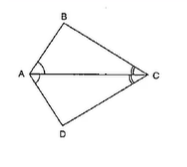If four sides of a quadrilateral ABCD are tangential to a circle, then AC+AD=BD+CD (b) AB+CD=BC+AD (c) AB+CD=AC+BC (d) AC+AD=BC+DB
To solve the problem regarding the quadrilateral ABCD with sides tangential to a circle, we can use the properties of tangents drawn from an external point to a circle. Here’s a step-by-step solution:
Step 1: Understand the Properties of Tangents
When a quadrilateral has a circle inscribed in it (is tangential), the lengths of the tangents drawn from each vertex to the points of tangency are equal.
Let:
- AP and AS be the tangents from point A,
- BP and BQ be the tangents from point B,
- CR and QC be the tangents from point C,
- DR and DS be the tangents from point D.
From these points, we can establish the following equalities:
- AP=AS
- BP=BQ
- CR=QC
- DR=DS
Step 2: Set Up the Equations
From the properties of tangents, we can express the lengths of the sides of the quadrilateral in terms of the tangent segments:
- AB=AP+PB
- BC=BQ+QC
- CD=CR+DR
- DA=DS+AS
Step 3: Write the Relationships
Using the equalities from Step 1, we can write:
1. AB+CD=AP+PB+CR+DR
2. BC+DA=BQ+QC+DS+AS
Step 4: Combine the Relationships
Now we can combine the relationships:
- From the left side: AB+CD=AP+PB+CR+DR
- From the right side: BC+DA=BQ+QC+DS+AS
Since AP=AS, BP=BQ, CR=QC, and DR=DS, we can simplify:
- AB+CD=BC+DA
Step 5: Identify the Correct Condition
Now we can check the options provided:
- (a) AC+AD=BD+CD - Incorrect
- (b) AB+CD=BC+AD - Correct
- (c) AB+CD=AC+BC - Incorrect
- (d) AC+AD=BC+DB - Incorrect
Thus, the correct condition is:
Option (b): AB+CD=BC+AD
When a quadrilateral has a circle inscribed in it (is tangential), the lengths of the tangents drawn from each vertex to the points of tangency are equal.
- AP and AS be the tangents from point A,
- BP and BQ be the tangents from point B,
- CR and QC be the tangents from point C,
- DR and DS be the tangents from point D.
- AP=AS
- BP=BQ
- CR=QC
- DR=DS
From the properties of tangents, we can express the lengths of the sides of the quadrilateral in terms of the tangent segments:
- AB=AP+PB
- BC=BQ+QC
- CD=CR+DR
- DA=DS+AS
Using the equalities from Step 1, we can write:
1. AB+CD=AP+PB+CR+DR
2. BC+DA=BQ+QC+DS+AS
Now we can combine the relationships:
- From the left side: AB+CD=AP+PB+CR+DR
- From the right side: BC+DA=BQ+QC+DS+AS
- AB+CD=BC+DA
Now we can check the options provided:
- (a) AC+AD=BD+CD - Incorrect
- (b) AB+CD=BC+AD - Correct
- (c) AB+CD=AC+BC - Incorrect
- (d) AC+AD=BC+DB - Incorrect
Option (b): AB+CD=BC+AD
Topper's Solved these Questions
Similar Questions
In a quadrilateral ABCD , given that ∠A+∠D=90o . Prove that AC2+BD2=AD2+BC2 .
View SolutionIn Fig. 10.78, if AD, AE and BC are tangents to the circle at D, E and F respectively. Then, (FIGURE) AD=AB+BC+CA (b) 2AD=AB+BC+CA (c) 3AD=AB+BC+CA (d) 4AD=AB+BC+CA
View SolutionIn Figure, diagonal AC of a quadrilateral ABCD bisects the angles A and C . Prove that AB=AD and CB=CD

View SolutionIn an equilateral triangle ABC if AD⊥BC, then AD2 = (a)CD2 (b) 2CD2 (c) 3CD2 (d) 4CD2
View SolutionDiagonals AC and BD of a quadrilateral ABCD intersect at O in such a way that ar (AOD)=ar ( BOC). Prove that ABCD is a trapezium.
View SolutionCalculate the area of the quadrilateral ABCD as shown in Fig.33, given that BD=42 cm , AC=28 cm , OD=12 cm and AC⊥BD .
View SolutionDiagonals AC and BD of a quadrilateral ABCD intersect at O in such a way that ar(AOD)=ar(BOC) . Prove that ABCD is a trapezium.
View SolutionABCD is a cyclic quadrilateral whose diagonals AC and BD intersect at P. If AB=DC, prove that:
(i)PAB ≅PDC
(ii)PA=PD and PC=PB (iii) AD∣∣BC
View SolutionABCD is a quadrilateral in which and∠DAB =∠CBA(see Fig. 7.17). Prove that
(i) ΔABD≅ΔBAC
(ii) BD = AC
(iii) ∠ABD =∠BAC

View SolutionThe diagonals of quadrilateral ABCD,ACandBD intersect in O. Prove that if BO=OD, the triangles ABCandADC are equal in area.
View Solution
